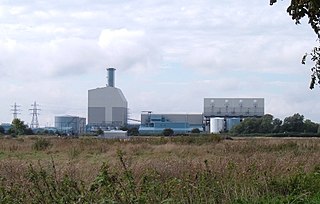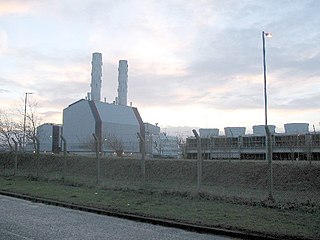
A power station, also referred to as a power plant and sometimes generating station or generating plant, is an industrial facility for the generation of electric power. Power stations are generally connected to an electrical grid.

A combined cycle power plant is an assembly of heat engines that work in tandem from the same source of heat, converting it into mechanical energy. On land, when used to make electricity the most common type is called a combined cycle gas turbine (CCGT) plant, which is a kind of gas-fired power plant. The same principle is also used for marine propulsion, where it is called a combined gas and steam (COGAS) plant. Combining two or more thermodynamic cycles improves overall efficiency, which reduces fuel costs.

A thermal power station is a type of power station in which heat energy is converted to electrical energy. In a steam-generating cycle heat is used to boil water in a large pressure vessel to produce high-pressure steam, which drives a steam turbine connected to an electrical generator. The low-pressure exhaust from the turbine enters a steam condenser where it is cooled to produce hot condensate which is recycled to the heating process to generate more high pressure steam. This is known as a Rankine cycle.

Didcot power station is an active natural gas power plant that supplies the National Grid. A combined coal and oil power plant, Didcot A, was the first station on the site, which opened in 1970 and was demolished between 2014 and 2020. The power station is situated in Sutton Courtenay, near Didcot in Oxfordshire, England. Didcot OCGT is a gas-oil power plant, originally part of Didcot A and now independent. It continues to provide emergency backup power for the National Grid.
Hal B. Wansley Power Plant is a power station located in northeastern Heard County, between Franklin and Carrollton, in the state of Georgia, United States. Its various units, powered by coal, oil, and natural gas, are operated by Southern Company, Georgia Power Company, Oglethorpe Power Corporation, Municipal Electric Authority and Dalton Utilities.

Damhead Creek power station is a 792 MWe gas-fired power station in Kent, England, on the Hoo Peninsula, It is near the site of the decommissioned Kingsnorth power station. The plant entered service in February 2001.

Grain Power Station is a 1,275 megawatts (1,710,000 hp) operational CCGT power station in Kent, England, owned by Uniper. It was also the name of an oil-fired, now demolished, 1,320MW power station in operation from 1979 to 2012.

The Littlebrook Power Station were a series of four oil and coal-fired power stations situated on the south bank of the River Thames, next to the Queen Elizabeth 2 Bridge and the Dartford Tunnel in Dartford, Kent. The final power station, Littlebrook D, ceased operating in March 2015, and has now been demolished.

King's Lynn Power Station refers to a combined cycle natural gas power station near King's Lynn in Norfolk, commissioned in 1997, and now owned by RWE, and to a coal fired power in King's Lynn in operation from 1899 to 1960. The CCGT station was mothballed on 1 April 2012. It can generate 325 MW of electricity and employed 40 people. The site was reopened on 19 November 2019.

Spalding Power Station is a 860 MW gas-fired power station one mile north of Spalding on West Marsh Road close to the River Welland. The current site provides enough electricity for one million households.

Glanford Brigg Power Station is a gas-fired power station in North Lincolnshire, England. It is capable of firing diesel as a substitute of natural gas. It is situated on the River Ancholme, beside the Sheffield to Cleethorpes via Brigg Line, outside the town of Brigg, with its name coming from the former name for the town. It has a generating capacity of 240 megawatts (MW).

South Humber Bank Power Station is a 1,365 MW gas-fired power station on South Marsh Road at Stallingborough in North East Lincolnshire north of Healing and the A180 near the South Marsh Road Industrial Estate. It is around two miles east of Immingham, and employs 64 people. The site of SHBPS is around 500 metres by 400 metres in area. It is next door to the Synthomer plant.

Peterborough Power Station is a 360MW gas-fired power station at Eastern Industry, Fengate in the city of Peterborough, Cambridgeshire in the United Kingdom. It employs around forty people.

Little Barford Power Station is a gas-fired power station just north of the village of Little Barford in Bedfordshire, England. It lies just south of the A428 St Neots bypass and east of the Wyboston Leisure Park. The River Great Ouse runs alongside. It was formerly the site of two coal-fired power stations, now demolished. The station is operated by RWE.

Great Yarmouth Power Station is combined cycle gas turbine power station on South Denes Road in Great Yarmouth in Norfolk, England, with a maximum output of 420 MW electricity, opened in 2001. It is built on the site of an oil-fired power station, built in 1958 and closed and demolished in the 1990s. A coal-fired power station was built in Great Yarmouth in 1894 and operated until 1961. The station is operated by RWE.

Roosecote Power Station was a gas-fired, originally coal-fired power station, situated in the Roosecote district of Barrow-in-Furness in Cumbria, North West England. The gas-fired station opened in 1991 and was the first CCGT power station to supply electricity to the United Kingdom's National Grid, but was mothballed in 2012 after a proposed biomass power station was cancelled. It was situated directly adjacent to Rampside Gas Terminal. The plant was demolished between 2014 and 2015. The site is now a 49 MW battery storage facility.

Deeside Power Station is a power station on the Deeside Industrial Park to the north of Connah's Quay in Flintshire, Wales. Constructed as a 498 MWe combined-cycle gas plant, it is now used to provide inertial response and reactive power services to the grid.

Pembroke B Power Station is a 2,200 MWe natural gas-fired power station near Pembroke in Wales. The power station was officially opened in September 2012 and is the largest gas-fired power station in Europe. It is also the largest power station to be built in the UK since Drax power station came online in 1986. Pembroke Power Station currently generates enough power to supply 3.5 million homes and businesses. It is operated by RWE.

The main power supply for Shetland is provided by Lerwick Power Station, located in Gremista, 2 kilometres (1.2 mi) northwest of Lerwick town centre. This is the principal source of electrical energy for Shetland, however currently about 20 MWe is provided by the Sullom Voe Terminal power station which comprises 4 x 23 MWe Gas Turbines, the future of which is uncertain. Opened on 27 May 1953 the station is diesel-fuelled and generates a total of 66 MW of power.

Killingholme A Power Station was a combined‐cycle gas turbine natural gas power station within the civil parish of North Killingholme, in North Lincolnshire, Lincolnshire, England. The facility lies north of the Lindsey Oil Refinery, and adjacent to Killingholme B power station.




















